Well impedance curves can show all sorts of things, like reflections and break-up.
For beak-up, we can do disapear (almost) with calbration.
Here, a calibrate compression driver impedance:
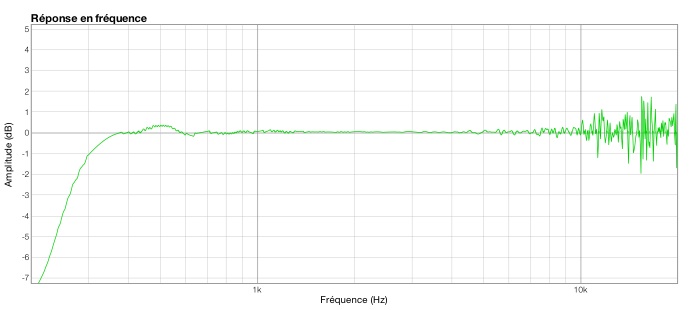
With it, we have a not too bad microphone with the compression driver.
OK, I did a few impedance sweeps. Here are the two of interest.
There is the 511-806 nominal, and then with a thick piece of cardboard loosely over the mouth. This was done to generate reflections, which it did very well.
I also draped a beach towel over the mouth. The results were very similar to the cardboard, but a little lower in amplitude.
Also did towels and foam around the outside of the mouth, it showed a dlight improvement over no soft lips.
At least this may tell us where the reflections are in this horn.
There is the 511-806 nominal, and then with a thick piece of cardboard loosely over the mouth. This was done to generate reflections, which it did very well.
I also draped a beach towel over the mouth. The results were very similar to the cardboard, but a little lower in amplitude.
Also did towels and foam around the outside of the mouth, it showed a dlight improvement over no soft lips.
At least this may tell us where the reflections are in this horn.
Attachments
Because this is an interesting subject, I decided to try a few different horn types.
I have ordered a few horns and waveguides from Part Express to try.
What I have coming is:
Also got bolt-on to screw adapters.
That should give a good variety of horns and waveguides to test.
I have ordered a few horns and waveguides from Part Express to try.
What I have coming is:
- Dayton H08RW 8" Round Waveguide
- Dayton H12RW 12" Round Waveguide
- Dayton H812 1" Exponential Horn 100x60 2-Bolt
- Pyle Pro PH612 1" Screw-On Constant Radiation Horn
Also got bolt-on to screw adapters.
That should give a good variety of horns and waveguides to test.
Because this is an interesting subject, I decided to try a few different horn types.
I have ordered a few horns and waveguides from Part Express to try.
What I have coming is:The Pyle horn is out of stock, so it will be for later.
- Dayton H08RW 8" Round Waveguide
- Dayton H12RW 12" Round Waveguide
- Dayton H812 1" Exponential Horn 100x60 2-Bolt
- Pyle Pro PH612 1" Screw-On Constant Radiation Horn
Also got bolt-on to screw adapters.
That should give a good variety of horns and waveguides to test.
haha, I would have shipped most of them to you for testing 😉
Because this is an interesting subject, I decided to try a few different horn types.
I have ordered a few horns and waveguides from Part Express to try.
What I have coming is:The Pyle horn is out of stock, so it will be for later.
- Dayton H08RW 8" Round Waveguide
- Dayton H12RW 12" Round Waveguide
- Dayton H812 1" Exponential Horn 100x60 2-Bolt
- Pyle Pro PH612 1" Screw-On Constant Radiation Horn
Also got bolt-on to screw adapters.
That should give a good variety of horns and waveguides to test.
The throat is rough on those waveguides. Do you have any plans on smoothing them out? I'll be most interested in what you find in your tests. I'm using the 10" variety and the sound is quite good. Actually I prefer the 12s, but they don't match my MWoofers as well. No honk that I've noticed, but I rarely take these things to extreme levels.
Dan
Hello Jean-Michel,
I mean the reflections/diffractions as indicated here:
There is strong reflections/diffractions at 1ms and 2ms. The Hornresp does not give a clue about those. You say the reason is TAD driver conical part, but as 1ms corresponds to 34cm and 2ms 70cm and these delays are quite large, is it right? What are the dimensions of the TAD TD2001 conical part?
- Elias
I mean the reflections/diffractions as indicated here:
An externally hosted image should be here but it was not working when we last tested it.
There is strong reflections/diffractions at 1ms and 2ms. The Hornresp does not give a clue about those. You say the reason is TAD driver conical part, but as 1ms corresponds to 34cm and 2ms 70cm and these delays are quite large, is it right? What are the dimensions of the TAD TD2001 conical part?
- Elias
You are wrong, Hornresp is perfecly able to simulate the reflection inside the horn.
I once gave as an example of the ability of Hornresp to predict the reflections the CSD of the pulse response of a tube (you'll find it in attached file).
Results of BEM has also demonstrated that the Le Cléac'h horn has the lowest reflection coefficients at frequency above 1.5 Fc.
Most large spectrum reflections you see resides inside the conical part of the output of the TAD TD2001 itself.
Well Doug, I wished I'd asked! 😀 Oh well, I needed some other stuff anyway....
Dan, yes, I will try to smooth them out. I did so on some small Selenium horns, but could not tell if it mattered.
The bolt to screw adapter will have its own issues.
Just for fun, if anyone cares to hear what I sound like speaking into the 511 horn, I'll post the MP3. ;-/
Dan, yes, I will try to smooth them out. I did so on some small Selenium horns, but could not tell if it mattered.
The bolt to screw adapter will have its own issues.
Just for fun, if anyone cares to hear what I sound like speaking into the 511 horn, I'll post the MP3. ;-/
Hello Jean-Michel,
I'd like to make a comment of this CSD you posted:
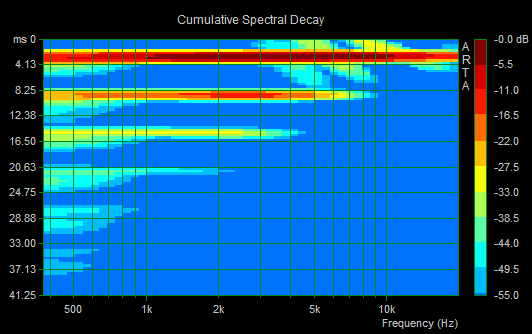
Seems to be that the time between reflections/diffractions is 6ms. That is about 2m! It's a little bit long for real life, don't you think so? 😉
How about more realistic case, where time between reflections is 1ms. Here is a theoretical impulse response containing a row of ideal reflections between 1ms. For convenience each reflection is 6dB lower in amplitude than the previous one.
http://dl.dropbox.com/u/2400456/diyaudio/Ideal_reflections_16bit_44100.wav
And here a wavelet transform of the ideal reflections:
It would be interesting to see what would be the 'best' CSD one could possible get out of this IR!! 🙂
- Elias
I'd like to make a comment of this CSD you posted:

Seems to be that the time between reflections/diffractions is 6ms. That is about 2m! It's a little bit long for real life, don't you think so? 😉
How about more realistic case, where time between reflections is 1ms. Here is a theoretical impulse response containing a row of ideal reflections between 1ms. For convenience each reflection is 6dB lower in amplitude than the previous one.
http://dl.dropbox.com/u/2400456/diyaudio/Ideal_reflections_16bit_44100.wav
And here a wavelet transform of the ideal reflections:
An externally hosted image should be here but it was not working when we last tested it.
It would be interesting to see what would be the 'best' CSD one could possible get out of this IR!! 🙂
- Elias
I once gave as an example of the ability of Hornresp to predict the reflections the CSD of the pulse response of a tube (you'll find it in attached file).


Remember to post the IRs 😀
- Elias
Because this is an interesting subject, I decided to try a few different horn types.
I have ordered a few horns and waveguides from Part Express to try.
What I have coming is:The Pyle horn is out of stock, so it will be for later.
- Dayton H08RW 8" Round Waveguide
- Dayton H12RW 12" Round Waveguide
- Dayton H812 1" Exponential Horn 100x60 2-Bolt
- Pyle Pro PH612 1" Screw-On Constant Radiation Horn
Also got bolt-on to screw adapters.
That should give a good variety of horns and waveguides to test.
Here is a theoretical impulse response containing a row of ideal reflections between 1ms.
Ideal maybe, impossible sure.
Here, in red, a measure of acoustic energy wich come back to compression driver with a tube:
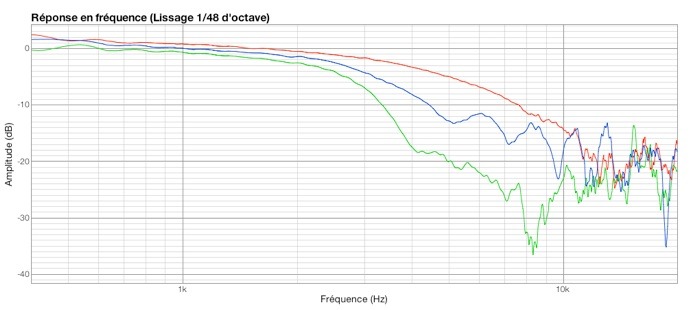
The higher frequencies leave the 1" (25mm) tube (or driver) without horn and progressively without reflection.
If we close the tube, it's possible but the IR of echos turn to 180°.
Also, the menbrane of driver absorb the sound with not linearity, so the second, third... echos are not linear in frequency too.
Let's say welcome to the steps!
While not the best, here is a stab at the ideal reflections in ARTA.
CSD and burst (freq)
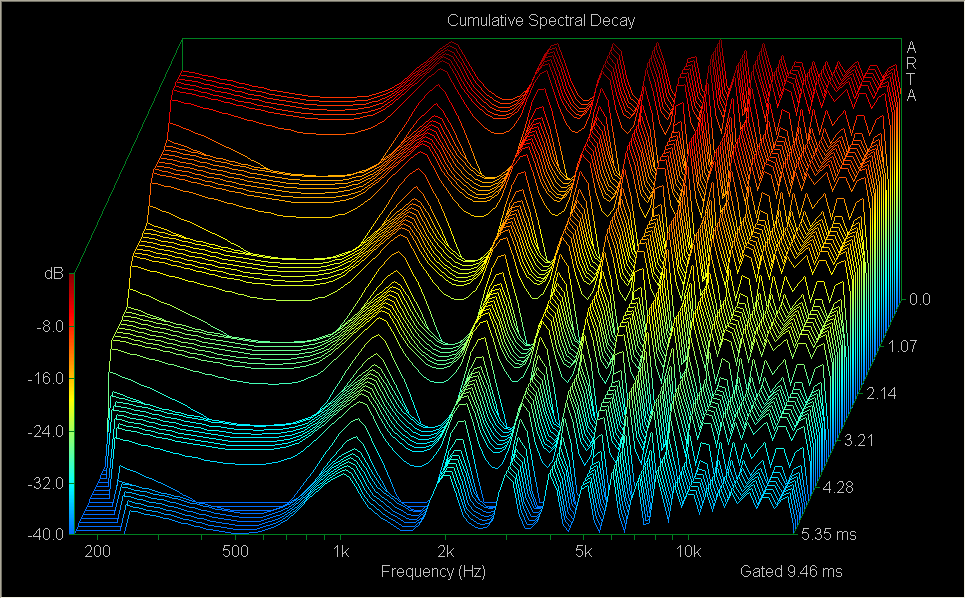
Ideal maybe, impossible sure.
Yes, ideal as stated. Impossible.. Well, never say never 😀
Of course the point was to demonstrate the difference between the CSD and the wavelets.
- Elias
511 as microphone
Just for giggles, here is a snip of a recording I made using the 511-806 as a microphone. A bit muffled, but the FR does roll off when used as a speaker.
I also did a longer one, walking toward and away from the horn. (sorry, had to zip to upload)
Just for giggles, here is a snip of a recording I made using the 511-806 as a microphone. A bit muffled, but the FR does roll off when used as a speaker.
I also did a longer one, walking toward and away from the horn. (sorry, had to zip to upload)
Attachments
Wow – such a lot of input again..
Great wavelet analysis with the normalized plots as well !
########
Nice investigation and conclusions about *discrete steps* in CSD analysis so far !
It's sort of backs up that I do not think those steps are *all* from room response issue ( but I could be wrong of course).
- First of all what makes me believe so, is that you do not see that behaviour in each and every measurement (at least I haven't in *mine*).
- second I neither have the files from that closed pipe etc. enclosure investigation back then (didn't own a license then) nor did I find my notes of what exactly I measured. but I do remember that most of those measurements were taken with the speaker lying on the floor (half room) and the mic placed as close to the membrane as possibly to further avoid room influence.
Sadly I not even have the ST350 available at the moment to do outdoor measruements (pano do you have possibility to do a outdoor measurement of those Altec horns that already did show same behaviour?)...
Will see how *I* possibly can verify any further that those decay in steps is speaker related (will have to ask for the ST 350 again).
#########
I agree – for comparison of drivers and correlating subjective findings about honk this is a good idea and the limits proposed make perfectly sense to me.
For any "looking over the fence" to possibly hunt horn honk wherever we might think, we should keep frame of investigation open.
Also, lets not forget that with Fourier / CSD and Wavelet analysis we are only catch part of what's horn honk melange IMO.
Michael
Great wavelet analysis with the normalized plots as well !
########
-
Maybe we should not only look at how quick decay happens, but even more so *how* decay looks like ?
FWIW, here is the ARTA sonogram from my 811-802D measurement.
....
.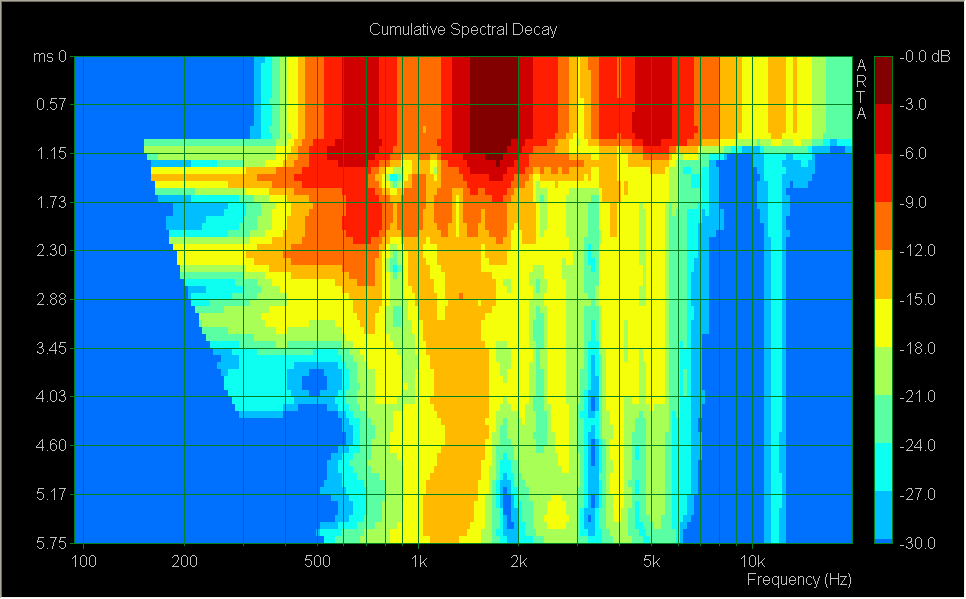
-
This is most interesting form me.
....
An externally hosted image should be here but it was not working when we last tested it.
BTW
below are measurements of the ElectroVoice ST350 that's more or less the same braid ...
...


Something additional that sticks out is that the ripples in FR do not match that well the ripples in CSD later on in time – same behaviour also to be seen in your "normalized" plot:
IMG]http://www.audioheritage.org/vbulletin/attachment.php?attachmentid=32678&stc=1&d=1211945341[/IMG]
Michael, I think going out to 200+ ms is showing the room more than the horn. It should be ungated but set the CSD settings so it's just showing the first few ms of the tail.
Hello,
Do you have the impulse response of that data? 😀
I'm almost most certain that everytime time passes a room reflection, the CSD drops a step
- Elias
A CSD should not show steps.
I once gave as an example of the ability of Hornresp to predict the reflections the CSD of the pulse response of a tube (you'll find it in attached file).
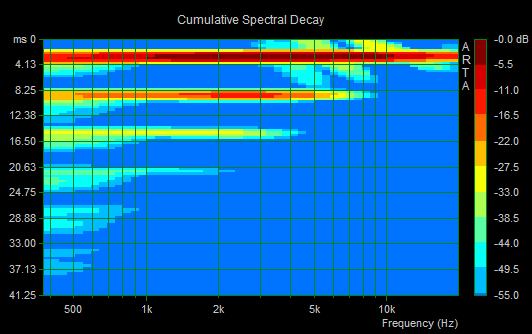
How about more realistic case, where time between reflections is 1ms. Here is a theoretical impulse response containing a row of ideal reflections between 1ms. For convenience each reflection is 6dB lower in amplitude than the previous one.
http://dl.dropbox.com/u/2400456/diyaudio/Ideal_reflections_16bit_44100.wav
And here a wavelet transform of the ideal reflections:
An externally hosted image should be here but it was not working when we last tested it.
It would be interesting to see what would be the 'best' CSD one could possible get out of this IR!! 🙂
While not the best, here is a stab at the ideal reflections in ARTA.
CSD and burst (freq)
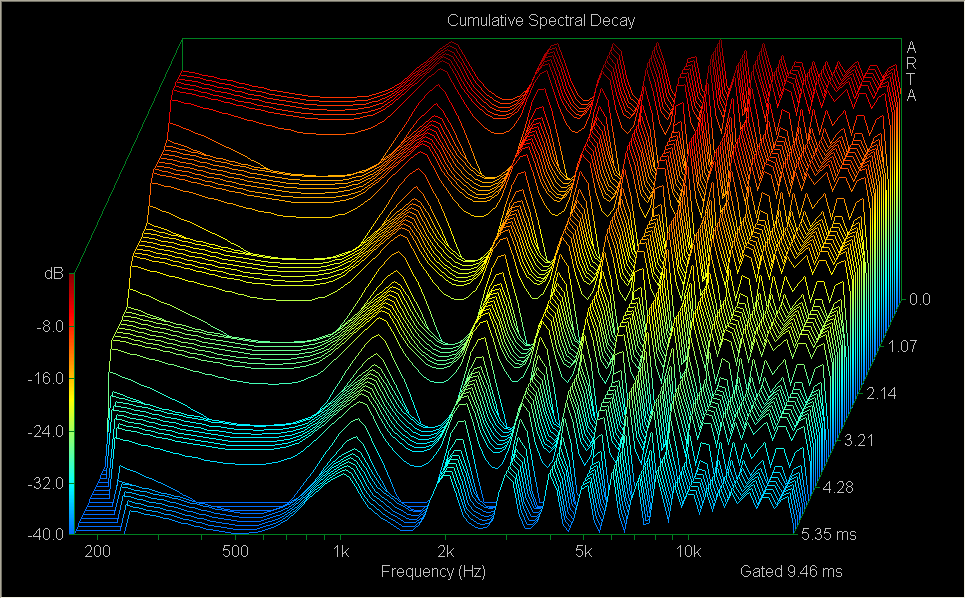
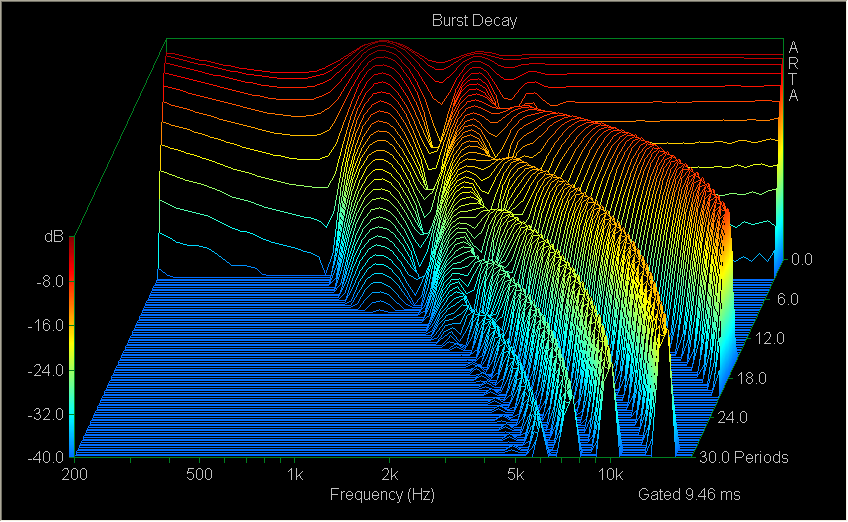
Let's say welcome to the steps!
Nice investigation and conclusions about *discrete steps* in CSD analysis so far !
It's sort of backs up that I do not think those steps are *all* from room response issue ( but I could be wrong of course).
- First of all what makes me believe so, is that you do not see that behaviour in each and every measurement (at least I haven't in *mine*).
- second I neither have the files from that closed pipe etc. enclosure investigation back then (didn't own a license then) nor did I find my notes of what exactly I measured. but I do remember that most of those measurements were taken with the speaker lying on the floor (half room) and the mic placed as close to the membrane as possibly to further avoid room influence.
Sadly I not even have the ST350 available at the moment to do outdoor measruements (pano do you have possibility to do a outdoor measurement of those Altec horns that already did show same behaviour?)...
Will see how *I* possibly can verify any further that those decay in steps is speaker related (will have to ask for the ST 350 again).
#########
It does seem that interpreting all these various charts and measurements is going to be tricky. Not only are the test rigs different, but the way the software is used is very different. If we are going to use ARTA to generate graphs, perhaps we need to lay down some rules so that we are all doing it the same way.
.....
So. We should standardize, at least in this thread. I suggest we use.
.
- 40dB scale. This shows deep enough without missing anything important.
- We decide how far (in milliseconds) before and after the impulse peak to set the gate or cursors.
- I suggest 1mS before and 5mS after. But am open to suggestions.
- Other parameters should be set, such as window type, FFT, ect.
I agree – for comparison of drivers and correlating subjective findings about honk this is a good idea and the limits proposed make perfectly sense to me.
For any "looking over the fence" to possibly hunt horn honk wherever we might think, we should keep frame of investigation open.
Also, lets not forget that with Fourier / CSD and Wavelet analysis we are only catch part of what's horn honk melange IMO.
Michael
Last edited:
Hello Elias,
Reflection inside a horn induces a part of the energy of the incident (direct) wave to go back toward the diaphragm when it encounters a rapid variation in the profile or in the flare of the horn. (then the refelcted wave can also propagate toward the mouth and encounter another refelction)
In a tube the only reflector is the termination that's means the mouth.
The example I shown is for a tube having a length of 1.16meter.
As you can see on the attached file, the pulse reflections for a given distance from diaphragm to mouth are sepated by 2 times the duration of a travel throat-mouth, that means that for a 1.16 meter tube the reflection will travel 2.32m ; 4.64m, etc more distance than the direct wave that means also that they will be delayed of 6.74ms; 13,49ms...
I don't see anything unrealistic in that example!
Best regards from Paris France
Jean-Michel Le Cléac'h
Reflection inside a horn induces a part of the energy of the incident (direct) wave to go back toward the diaphragm when it encounters a rapid variation in the profile or in the flare of the horn. (then the refelcted wave can also propagate toward the mouth and encounter another refelction)
In a tube the only reflector is the termination that's means the mouth.
The example I shown is for a tube having a length of 1.16meter.
As you can see on the attached file, the pulse reflections for a given distance from diaphragm to mouth are sepated by 2 times the duration of a travel throat-mouth, that means that for a 1.16 meter tube the reflection will travel 2.32m ; 4.64m, etc more distance than the direct wave that means also that they will be delayed of 6.74ms; 13,49ms...
I don't see anything unrealistic in that example!
Best regards from Paris France
Jean-Michel Le Cléac'h
Hello Jean-Michel,
I'd like to make a comment of this CSD you posted:

Seems to be that the time between reflections/diffractions is 6ms. That is about 2m! It's a little bit long for real life, don't you think so? 😉
How about more realistic case,
Attachments
Hello Thend,
Just to illustrate the possibilty for reflections to be identified on an impedance curve, here is attached, for the same 1.16meter long tube I previously took as an example, how they will be seen in the frequency domain.
Best regards from Paris, France
Jean-Michel Le Cléac'h
Just to illustrate the possibilty for reflections to be identified on an impedance curve, here is attached, for the same 1.16meter long tube I previously took as an example, how they will be seen in the frequency domain.
Best regards from Paris, France
Jean-Michel Le Cléac'h
Maybe to use the inpedance curve for (quasi)free room reflection.
And maybe a tube between!
Attachments
- Status
- Not open for further replies.
- Home
- Loudspeakers
- Multi-Way
- Horn Honk $$ WANTED $$





